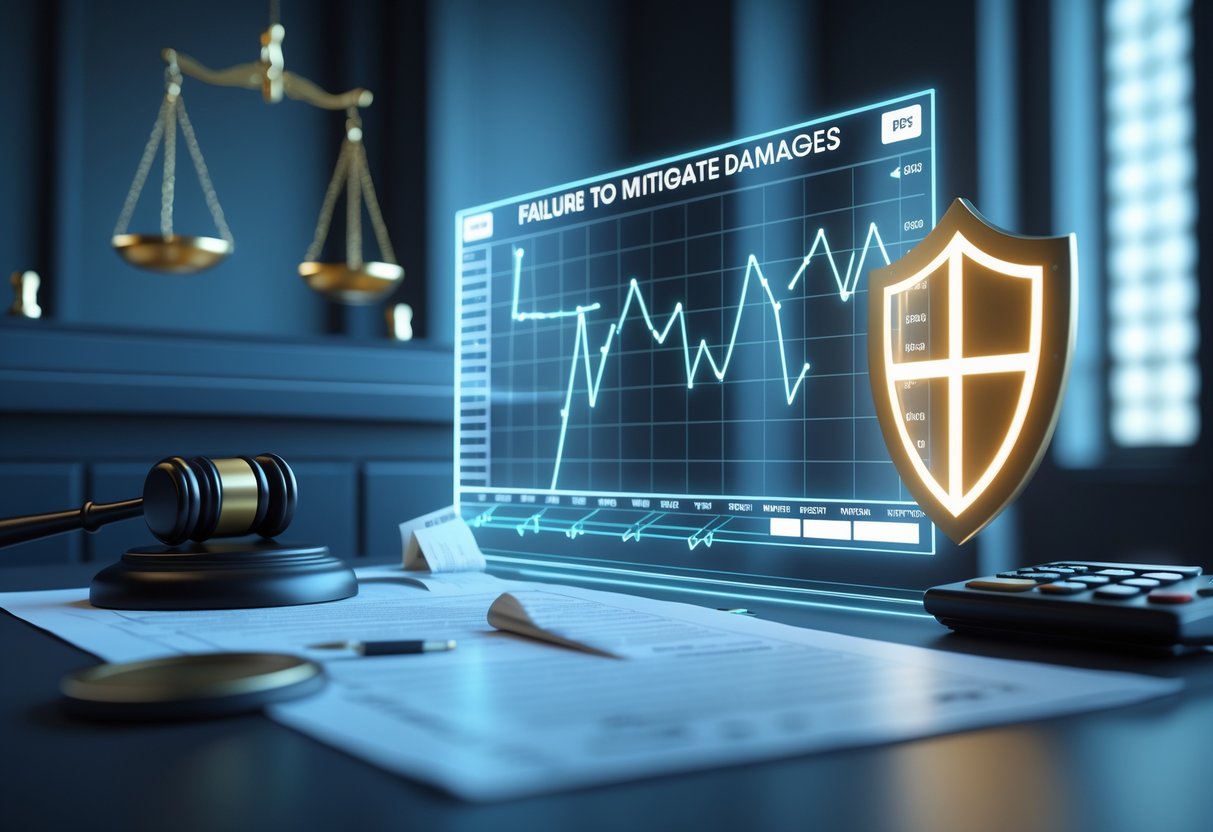Damage Mitigated Importance: Why Minimising Losses Matters in Law
Updated On: November 13, 2025 by Aaron Connolly
What Is Damage Mitigation?
Damage mitigation means that when someone gets hurt by a contract breach, they have to try to limit their losses. The law expects people to act, not just watch damages pile up, so compensation stays fair and doesn’t spiral out of control.
Definition of Mitigation of Damages
Mitigation of damages is this core legal idea that pushes the injured party in a contract dispute to keep their losses as low as possible. If someone breaches a contract, the other side can’t just let everything fall apart and expect full compensation.
Courts want to see people taking reasonable steps to help themselves. If you don’t, you might get less money in the end.
This principle pops up in all sorts of legal situations. In employment law, for example, workers who get fired unfairly have to look for new jobs. Landlords dealing with abandoned property need to try to re-let it.
Key requirements include:
- Acting quickly once you spot the breach
- Making a real effort to reduce your losses
- Keeping records of what you’ve done to mitigate
- Picking reasonable solutions instead of expensive or extreme ones
But the law doesn’t expect miracles. You only need to do what’s practical and makes sense for your situation.
Key Principles of Damage Mitigation
The doctrine of avoidable consequences sits at the heart of damage mitigation. It stops people from collecting damages they could have dodged with a bit of effort.
Courts look at whether your actions were reasonable. They judge you by what a sensible person would do in your shoes, considering your resources, time, and what’s normal in your industry.
Core principles include:
| Principle | Description |
|---|---|
| Reasonableness | Actions should make sense, not be perfect |
| Prompt action | Start mitigation as soon as you can |
| Good faith | Make honest attempts to limit loss |
| Proportionality | Efforts should fit the size of the damages |
Usually, the breaching party has to prove the other side didn’t try hard enough to mitigate. That keeps everyone on their toes.
Doctrine of Avoidable Consequences
The doctrine of avoidable consequences says you can’t recover damages that you could have prevented. It pushes people to fix problems instead of just letting them get worse.
If you don’t try to avoid extra losses, you lose the right to claim them. For instance, if a supplier bails on you, you need to look for another source. Ignoring that option might mean you can’t collect all your extra costs.
Common applications include:
- Job seekers in employment disputes
- Landlords re-letting property
- Businesses finding substitute suppliers
- Service users turning to alternative providers
Courts check if your mitigation efforts were good enough. They look at your situation, your options, and whether your response made sense.
This doctrine tries to keep things fair. It lets injured people get what they deserve, but it stops anyone from demanding damages that could have been avoided.
Understanding the Importance of Damage Mitigated
Damage mitigation stands as a foundation for fairness in law. It makes sure compensation matches real, unavoidable losses instead of preventable ones.
This principle protects everyone by encouraging people to act responsibly after a breach. It also keeps financial liability in check.
Promoting Fairness in Contract Law
The duty to mitigate damages creates balanced accountability between both sides of a contract. If one side breaks a deal, the other can’t just let things get worse and expect a payout.
Instead, they need to take steps to cut down their losses. That way, the breaching party doesn’t get punished for damages that could have been avoided.
Courts keep reminding us that mitigation efforts should be reasonable, not over-the-top. If you’re fired unfairly, you should look for similar work, but you don’t have to take a job that’s beneath you or move across the country.
This approach shields injured parties from crazy expectations, but it also keeps defendants from paying for things that could have been fixed.
Key fairness principles include:
- Reasonable effort is enough
- No need for heroic measures
- Mitigation gets judged objectively
- No one has to accept a bad deal just to cut losses
The doctrine ties back to basic legal ideas about personal responsibility. It blocks situations where someone profits from just doing nothing after being harmed.
Avoiding Unnecessary Economic Loss
Damage mitigation helps economic efficiency by cutting down waste when things go wrong. Without it, people might let losses build up, costing everyone more in the end.
Think about a landlord whose tenant moves out early. The law makes them look for a new tenant instead of leaving the place empty.
This keeps the total loss lower. The landlord gets reasonable compensation, and the tenant doesn’t have to pay for months of empty rent.
Economic benefits include:
- Less overall financial pain
- Quicker problem-solving
- Smaller compensation claims
- Better use of resources
This principle nudges people to fix issues quickly. It leads to better results for everyone and takes some pressure off the courts.
Duty to Mitigate Damages
When someone breaks a contract or causes harm, the injured party can’t just sit around and let things get worse. The law expects reasonable steps to limit further damage, so both sides get a fair deal.
Scope and Application of Duty
The duty to mitigate pops up in lots of legal areas. You see it all the time in contract fights, injury cases, and property disputes.
In contract law, if someone breaks a promise, the other side has to try to limit their losses. They can’t keep doing things that make the damages worse.
Property law uses this rule a lot too. If tenants walk out, landlords have to look for new tenants instead of letting the place sit empty.
In personal injury cases, victims are expected to get proper medical care. If they refuse reasonable treatment, their compensation might drop.
This doctrine stops people from taking advantage of a bad situation. It keeps things fair and prevents runaway liability.
Legal Requirements and Standards
Courts compare mitigation efforts to what a reasonable person would do. The focus is on what’s practical—not what’s perfect.
Key legal requirements include:
- Acting soon after you spot the breach or injury
- Considering realistic options that make sense financially
- Acting honestly to keep losses down
- Keeping records of what you tried
You don’t have to go above and beyond. Just do what most people would see as sensible.
If you have to spend some money to mitigate, you can often claim that back as part of your damages. Courts get that sometimes you need to spend a little to save a lot.
But if you don’t try hard enough, courts might cut your damages by what you could have saved.
Reasonable Steps and Reasonable Actions
What’s “reasonable” depends on the situation, but a few basics always apply. Your actions should be practical and match the size of the potential loss.
If you lose your job, you’re supposed to look for similar work. You can’t just wait for your old job back and expect full pay in damages.
Examples of reasonable mitigation:
- Getting medical help for injuries
- Finding new tenants or buyers
- Sourcing replacement suppliers
- Taking a comparable job if you’re fired
You don’t have to accept a bad deal. A top executive isn’t expected to take an entry-level job, and no one has to move across the country just to cut losses.
Courts look at each case on its own. What’s reasonable can change based on your personal circumstances and what’s going on in the market.
Reasonableness Standard in Damage Mitigation

Courts judge mitigation by what a reasonable person would actually do. The law wants practical steps to reduce loss—not perfection or endless sacrifice.
What Counts as Reasonable Efforts?
The reasonableness test checks if your actions made sense. You don’t need to chase down every possible option.
Key factors courts consider:
- What resources and money you had
- Industry standards and normal practices
- How much time you had to act
- How bad the original breach or damage was
If you lose your job unfairly, reasonable efforts might mean applying for similar positions. No one expects you to take a big pay cut just to find work.
In contract disputes, reasonable actions could be finding another supplier or service provider. You just need to show you acted like most sensible people would.
What makes efforts reasonable:
- You followed industry norms
- Your steps matched the size of the loss
- You didn’t take on huge risk or expense
- You acted within a sensible timeframe
Courts aren’t looking for flawless decision-making. They just want to see honest, practical attempts to keep losses down.
Limits of the Duty to Mitigate
The duty to mitigate has limits. No one has to take steps that are risky, expensive, or just plain unreasonable.
Common limits include:
- Financial burden: You don’t have to spend a lot to save a little
- Personal safety: You shouldn’t risk your health to cut losses
- Unrealistic alternatives: You can say no to bad substitutes
- Defendant’s interference: If the breaching party gets in your way
Employment cases make these limits obvious. A fired executive doesn’t need to take a minimum-wage job. The replacement should be pretty similar in pay and status.
In contract disputes, you don’t have to accept inferior goods or services just to save money. The alternative has to actually work for you.
Key exceptions to mitigation:
- You can’t act because of illness or injury
- The other side blocks your efforts
- Alternatives would cause serious hardship
- Industry practice doesn’t support the suggested mitigation
Once you show you did something to mitigate, the other side has to prove your efforts weren’t good enough.
Mitigation in Breach of Contract Cases
When a contract gets broken, the injured party can’t just let their losses stack up. They’re supposed to try to reduce the damage, and if they don’t, the breaching party can use that as a defense.
Role of the Injured Party
The injured party in a contract case has a legal duty to act sensibly. They need to try to limit their losses after the breach.
Key responsibilities include:
- Acting quickly once they know about the problem
- Trying reasonable alternatives
- Not doing things that make damages worse
Let’s say a supplier bails on you. You should look for replacement goods at a fair price, not just watch your business suffer.
You don’t have to go overboard or spend a fortune. The law just wants to see reasonable efforts.
If you don’t try to mitigate, courts can cut your damages by whatever you could have saved.
Examples in Commercial Contracts
Commercial contract disputes give plenty of real-world examples of mitigation.
Employment contracts: If an employer fires someone unfairly, that person needs to look for similar work. If they turn down reasonable offers, their payout drops.
Supply agreements: If a supplier backs out, the buyer should look for goods elsewhere at normal prices. Choosing the most expensive option and claiming full damages won’t work.
Property leases: When tenants leave early, landlords need to try to re-let the place. They can’t just leave it empty and claim full rent.
Construction contracts: If a contractor walks off the job, the property owner should protect the site and look for new workers. Ignoring the site and letting it get damaged would break their mitigation duty.
Defences for Failure to Mitigate
The breaching party can try to defend themselves by showing the other side didn’t do enough to limit their damages. If they succeed, they might owe a lot less.
Common defence strategies:
| Defence Type | What Must Be Proved |
|---|---|
| Unreasonable conduct | The injured party acted unreasonably |
| Better alternatives existed | Cheaper or better options were available |
| Deliberate inaction | The party chose not to act when they could have |
The breaching party has to prove what the injured party should have done differently. They need to point to specific actions, not just guesswork.
Courts look at whether the injured party acted reasonably, not whether they made perfect choices. There’s a bit of wiggle room here.
Timing really matters. If someone waits too long to try and fix things, the defence gets stronger.
Most successful defences focus on delays or ignoring obvious, practical ways to cut losses.
Evaluating Failure to Mitigate Damages

When someone doesn’t take reasonable steps to cut their losses after a contract breach, courts look closely at what they did. This can change how much money they get in the end, and they’ll need real evidence to show what happened.
Impact on Compensation
If courts decide someone failed to mitigate, they’ll usually cut the damages right away. The judge will figure out what losses could’ve been avoided if the person had acted sensibly.
Take a fired employee who turns down similar job offers—courts might subtract the wages they could’ve earned from their compensation. That’s because those losses were avoidable with some effort. Mitigation efforts matter here.
Courts don’t budge on this. They won’t pay for losses the injured party could have prevented. So, the final payout drops by however much should have been avoided.
They’ll look at:
- Actions taken to cut losses
- Reasonable alternatives available at the time
- How quickly the person acted
- Whether their approach was cost-effective
Sometimes, if someone’s actions are really unreasonable, courts might deny their claim for damages altogether. That’s a pretty harsh result, but it happens when people just sit on their hands.
Proving a Failure to Mitigate
The defendant usually has to prove the plaintiff didn’t try hard enough to limit damages. They need real proof—not just guesses—about what should have been done.
Courts check if there were reasonable alternatives and whether the plaintiff’s response matched the situation. They consider what resources and experience the plaintiff had at the time.
Useful evidence includes:
- Available job opportunities (for employment cases)
- Alternative suppliers or contractors
- Medical treatment options (in injury cases)
- Other market options for goods or services
Defendants have to show the plaintiff’s efforts didn’t stack up to what a reasonable person would do. Just pointing to alternatives isn’t enough—they must prove those options made sense and were actually available.
Keeping good records really helps. Plaintiffs who can show what they tried to do are in a much better spot. Courts like to see people actively looking for solutions, even if not every attempt worked out.
When judging these efforts, courts look at cost, risk, and whether the steps had a real shot at success.
Damage Mitigation in Employment Law

In employment law, workers have to look for new jobs after being wrongfully let go. Courts expect us to actually try, and they won’t pay damages for losses we could have avoided.
Lost Wages and Job Search Obligations
If we lose our job unfairly, we can’t just wait for a payout. The law says we have to make a real effort to find work.
Reasonable effort might mean:
- Applying for similar jobs
- Reaching out to people we know in the industry
- Using job sites and agencies
- Showing up for interviews
We should keep detailed notes about applications, dates, company names, and responses.
The kind of work we’re expected to take depends on our background. Specialists usually get more time to find a good fit than general workers.
Courts don’t expect us to take any job that comes along. The new role should be in line with our skills, experience, and pay range.
What we need to do:
- Document every application
- Apply to comparable jobs regularly
- Accept reasonable offers
- Keep searching until we land something
Reasonable Steps for Dismissed Employees
We don’t have forever to find a job, but courts get that some roles take longer. The important thing is to show we’re honestly trying.
Good mitigation steps:
- Retrain if our industry has changed
- Start a business if jobs aren’t out there
- Take temp work while searching for something permanent
- Move for the right opportunity, if it makes sense
We don’t have to settle for jobs that just aren’t right. That covers jobs with way less pay, different duties, or bad working conditions.
We don’t need to:
- Move far away without good reason
- Take big pay cuts
- Accept jobs we’re not qualified for
- Work somewhere hostile
This duty to mitigate only applies to lost wages. It doesn’t cover things like emotional distress or discrimination damages. We have to be active in our job hunt but don’t have to sell ourselves short.
Rental Property and Damage Mitigation

When tenants break leases early, both landlords and tenants have to limit their losses. Most states say landlords have to look for new tenants instead of just collecting rent from the person who left.
Landlord Responsibilities After Breach
Landlords in most states have to mitigate damages if tenants leave early. That means actively searching for new renters, not just letting the place sit empty.
This rule doesn’t apply in:
- Arkansas
- Florida
- Georgia
- Mississippi
- New Hampshire
- Pennsylvania
- South Dakota
- Wyoming
- Vermont
Reasonable steps include:
- Advertising the vacancy in multiple places
- Setting fair rent
- Showing the place to people interested
- Answering inquiries quickly
We can’t just wait for the lease to end and collect rent. The law expects us to actually try to re-rent the place as soon as possible.
If we find a new tenant, the old one stops owing rent when the new lease starts. They might still have to pay for things like ads or agent fees.
Tenant Actions to Limit Loss
Tenants who break a lease can also take steps to lower what they owe. These actions show good faith and may reduce rent owed.
Smart tenant moves:
- Give proper notice as the lease says
- Help find a new tenant, maybe through referrals
- Keep the place in good shape while vacant
- Document if the landlord isn’t trying to re-rent
We should stay in touch with the landlord about what’s happening. Sometimes, if we help get a replacement, landlords will let us out early with fewer penalties.
Heads up: Just leaving without notice almost always makes things worse. Courts prefer tenants who try to work things out.
Keep track of all messages and what the landlord does to re-rent. If the landlord doesn’t try, we might get our rent cut in court.
Damage Mitigation in Legal Disputes Outside Contracts

The duty to cut losses isn’t just for contracts—it shows up in tort claims and property disputes too. In these cases, the injured party has to take reasonable steps to prevent more harm or losses.
Tort Claims and Personal Injury
If you’re hurt and want compensation, you can’t just ignore your injury. The law says you need to get medical help and follow your doctor’s advice.
Say you break your leg in an accident. If you skip recommended physio, your payout might get cut if your injury gets worse.
Key things you should do:
- Get medical help right away
- Stick to your treatment plan
- Go to rehab sessions
- Try to get back to work when you can
Courts look at whether you acted reasonably. They consider:
| Factor | What Courts Look At |
|---|---|
| Medical compliance | Did you follow doctor’s orders? |
| Return to work efforts | Did you try suitable jobs? |
| Cost vs benefit | Were the steps financially sensible? |
You don’t have to go overboard. Just act like a reasonable person would in your shoes.
Construction and Real Estate
Property owners and contractors have their own duties to limit damage. In construction, owners should protect buildings and materials from further harm if something goes wrong.
If a tenant leaves early, the landlord needs to look for a new renter. They can’t just leave the place empty and demand full rent.
Common steps:
- Advertise vacancies quickly
- Accept reasonable new tenants
- Protect damaged buildings from weather
- Stop unnecessary work if a project gets cancelled
If there’s property damage, owners should prevent more harm—like covering a leaking roof or boarding up windows.
The main question is always reasonableness. Courts don’t expect owners to spend a fortune on quick fixes, but they do expect basic protection.
Mitigation of Damages in Sales and Goods Contracts

Sales contracts (under the UCC) spell out what buyers and sellers have to do when a contract dispute happens. These rules decide how much money each side can claim when things fall apart.
Seller and Buyer Obligations
If a buyer backs out, sellers can’t just sit on the goods and ask for full payment. They have to try to cut their losses—usually by reselling the goods at the best price they can get.
Sellers need to look for new buyers, maybe by advertising or reaching out to contacts. Just storing the goods and doing nothing isn’t good enough.
Buyers have duties too if sellers don’t deliver. If your order never arrives, you can’t just wait and claim huge damages. You should look for similar goods from someone else.
The main thing is to be “reasonable.” You don’t have to take a bad deal or spend a fortune, but you can’t ignore easy ways to limit your losses.
Keep records of what you do—like calls, ads, or offers. Courts want to see what you actually tried, not just what you say.
If you don’t try to mitigate, you’ll get less in damages. That way, the other party isn’t stuck paying for losses you could have avoided.
Real-Life Examples and Case Studies
A furniture maker gets an order for 100 custom chairs, but the buyer cancels. The maker can’t just demand full payment and let the chairs gather dust.
They need to try to sell the chairs elsewhere. If they find a buyer who pays 80% of the original price, after reasonable effort, they can only claim the 20% loss from the original buyer.
In retail, if a shop’s supplier fails to deliver winter coats in October, the shop should look for another supplier. They can’t just wait until January and say they lost all their winter sales.
Service contracts are a bit different. If a cleaning company breaks a contract, the building owner should hire someone else quickly. They can claim extra costs, but not damages from letting the place get dirty for months.
Courts want to see real, genuine mitigation efforts. One ad or one call usually isn’t enough, but you don’t have to try every last thing if your first efforts work.
The person asking for damages usually has to show what steps they took and why those steps made sense.
Calculating Damages with Mitigation in Mind

When courts figure out compensation, they look at both the original financial loss and the injured party’s efforts to cut down the harm. They need detailed documentation and a systematic look at all mitigation steps.
Process of Damage Assessment
Courts first identify the total financial loss before anyone tries to fix things. This covers immediate costs and the future hit to your finances.
Next, they check what reasonable steps you took to limit your losses. Say you lost your job—you’d need to show you seriously hunted for new work.
Key factors courts consider:
- Market value of losses at the time things went wrong
- Replacement costs for damaged property
- Lost income and potential future earnings
- Expenses you racked up while trying to mitigate
Courts use the “reasonable person” standard the whole way through. Would a regular person have taken similar steps to cut their losses? That’s the big question.
They also weigh how bad the damage is compared to what resources you had. If you’re strapped for cash, no one expects you to take on expensive solutions that make your situation worse.
Documentation and Record-Keeping
Good documentation backs up your mitigation efforts and protects your right to full compensation. Start keeping records as soon as you spot the breach or damage.
Essential documents include:
- Photos of the initial damage
- Receipts for repairs
- Job applications and interview notes
- Medical treatment paperwork
- Communication with the other side
It really helps to create a timeline of each mitigation step. Jot down dates, costs, and what happened after each action.
Financial experts often jump in to support damage calculations. They’ll look at your mitigation efforts and crunch the numbers on what those steps should reasonably cost.
If you can’t prove you tried to mitigate, courts might slash your compensation. Honestly, poor record-keeping can cost you a lot.
Keep your documents both digitally and in hard copy. Email confirmations, bank statements, and invoices from professionals all add strength when you’re seeking compensation for a financial hit.
Frequently Asked Questions

Damage mitigation raises plenty of practical questions. People want to know how to actually do it, what it costs, and if it really works. Here are some answers to the most common concerns across different industries and situations.
What are the key factors that contribute to effective damage mitigation strategies?
Effective mitigation always starts with risk assessment. You’ve got to spot possible threats early and figure out how bad they could get.
Quick planning matters a lot. Teams that jump into action within hours, not days, usually cut damage by 40-60%.
Clear communication is huge. Everyone needs to know their job and how to report problems fast.
You also need enough resources set aside for emergencies. That means both money and people who know what to do.
It’s smart to test your plans regularly. A lot of organisations only find weak spots when things go wrong for real.
How does damage mitigation impact long-term sustainability in environmental management?
Environmental mitigation protects ecosystems for the future. If we stop pollution or habitat loss, we keep resources that whole communities rely on.
Proactive steps usually cost way less than cleaning up later. For example, protecting a pipeline from oil spills costs about £10,000 per mile, but cleanup can hit £1 million per mile.
Mitigation helps biodiversity too. Protected areas and wildlife corridors give species a fighting chance as the climate and landscapes change.
Cutting carbon brings immediate air quality perks. Cities with strong mitigation efforts see 20-30% fewer respiratory illnesses.
Water protection programs keep drinking supplies safe. Towns that invest in watershed protection avoid pricey water treatment upgrades down the line.
In what ways do preventive measures play a role in reducing potential damage?
Prevention stops disasters before they happen. It usually costs just 10-20% of what a cleanup would.
Early warning systems buy us time. Flood alerts, for instance, let people move valuables and evacuate safely.
Regular maintenance keeps equipment from breaking down. Monthly checks catch about 80% of potential failures before they turn into bigger problems.
Training makes a difference too. Workers who know the warning signs can catch issues while they’re still small.
Building codes and safety rules act as shields. Structures built for earthquakes or hurricanes save lives and property when the worst happens.
Could you explain the role of technology in enhancing our ability to mitigate damage?
Modern sensors pick up problems fast. Smart buildings shut off water when pipes burst or cut power during electrical faults.
Satellites keep an eye on environmental changes over huge areas. We can spot deforestation, oil spills, or wildfire risks from space.
Data analytics help predict equipment failures. Airlines swap out parts before they break, which prevents dangerous malfunctions.
Communication tech speeds up emergency response. Mobile apps can warn thousands of people about evacuations in minutes.
Drones and robots take on risky inspections. They check damaged buildings or chemical spills so people don’t have to.
What are the economic benefits of investing in damage mitigation efforts?
Every pound spent on mitigation usually saves £3-7 in avoided damage. That return makes prevention programs a no-brainer for most businesses.
Insurance companies lower premiums for firms with strong mitigation practices. Businesses can cut coverage costs by 15-25% with solid risk reduction.
Good planning keeps companies running after a crisis. If you can get back on your feet fast, you keep your customers and your market share.
Property values hold steady in well-protected places. Homes with flood defences or earthquake retrofits go for higher prices.
Strong safety programs lower liability risk. They help companies avoid expensive lawsuits and fines.
How does damage mitigation relate to risk management in business settings?
Risk management spots threats, while mitigation comes up with action plans. When you put them together, they build a solid protection strategy for any business.
Regular risk assessments help us figure out what to tackle first. We usually target the most likely and expensive problems before anything else.
Business continuity plans lay out clear response steps. If something goes wrong, the team knows what to do and who to contact.
Diversifying the supply chain cuts down dependency risks. Companies with several suppliers can keep going even if one source drops out.
Staff training really matters here. Even the best mitigation plans fall apart if people don’t know how to carry them out.

